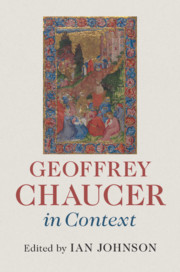Book contents
- Geoffrey Chaucer in Context
- Geoffrey Chaucer in Context
- Copyright page
- Contents
- Illustrations
- Contributors
- Abbreviations
- Introduction
- Part I Chaucer as Context
- Part II Books, Discourse and Traditions
- Part III Humans, the World and Beyond
- Part IV Culture, Learning and Disciplines
- Part V Political and Social Contexts
- Chapter 34 Dissent and Orthodoxy
- Chapter 35 The Church, Religion and Culture
- Chapter 36 England at Home and Abroad
- Chapter 37 Chaucer’s Borders
- Chapter 38 Rank and Social Orders
- Chapter 39 Chivalry
- Chapter 40 Chaucer and the Polity
- Chapter 41 The Economy
- Chapter 42 Towns, Villages and the Land
- Chapter 43 London’s Chaucer
- Chapter 44 Everyday Life
- Chapter 45 Household and Home
- Chapter 46 Marriage
- Chapter 47 Dress
- Part VI Chaucer Traditions
- Further Reading
- Index
Chapter 47 - Dress
from Part V - Political and Social Contexts
Published online by Cambridge University Press: 24 June 2019
- Geoffrey Chaucer in Context
- Geoffrey Chaucer in Context
- Copyright page
- Contents
- Illustrations
- Contributors
- Abbreviations
- Introduction
- Part I Chaucer as Context
- Part II Books, Discourse and Traditions
- Part III Humans, the World and Beyond
- Part IV Culture, Learning and Disciplines
- Part V Political and Social Contexts
- Chapter 34 Dissent and Orthodoxy
- Chapter 35 The Church, Religion and Culture
- Chapter 36 England at Home and Abroad
- Chapter 37 Chaucer’s Borders
- Chapter 38 Rank and Social Orders
- Chapter 39 Chivalry
- Chapter 40 Chaucer and the Polity
- Chapter 41 The Economy
- Chapter 42 Towns, Villages and the Land
- Chapter 43 London’s Chaucer
- Chapter 44 Everyday Life
- Chapter 45 Household and Home
- Chapter 46 Marriage
- Chapter 47 Dress
- Part VI Chaucer Traditions
- Further Reading
- Index
Summary
Ineffective 1363 English sumptuary laws inform comprehension of Geoffrey Chaucer’s costume rhetoric employed throughout his works. These laws, in effect for less than a year, proposed and set standards for socially and economically suitable garments for each social group.Chaucer’s Reeve’s Tale portrays a miller’s family, social climbers, who exploit these standards; his General Prologue’s Physician sartorially advertises his prosperous practice; and a stylish Merchant, ‘Flaundryssh’-hatted, proclaims his apparent affluence. Chaucer’s rhetorical expression of contemporary social and moral attitudes and practices illuminate his texts. Items VIII-XIV of these laws list society’s levels and prescribe suitable fabrics, embellishments, and prices for each. Chaucer’s Alison of his Miller’s Tale dresses transgressively when judged by these standards, while Chaucer’s nobles, generally, do not. He realistically portrays his religious figures and the poor. Finally, Chaucer summarises contemporary sartorial sins in his Parson’s Tale.
- Type
- Chapter
- Information
- Geoffrey Chaucer in Context , pp. 393 - 400Publisher: Cambridge University PressPrint publication year: 2019

